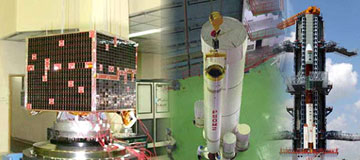About HAMSAT
HAMSAT is ISRO’s first theme based Micro-satellite meant for providing Satellite based Amateur Radio Services to the National as well as International Community of Amateur Radio Operators (HAMs).
Scheduled to be launched in May 2005 on-board the PSLV-C6 Mission as an Auxiliary Satellite, it will meet the long felt need for the Amateur Radio Operators of South Asian region who possess the required paraphernalia and operate in the UHF/VHF band based Satellite Radio Communication Channel.
The last Satellite in the LEO providing this type of service ceased operating in mid August 2003 and created a vacuum for the Mode B (UV) services. HAMSAT, once operational by June 2005, will greatly serve this purpose.
The HAMSAT Micro-satellite is India’s contribution to the international community of Amateur Radio Operators. This effort is also meant to bring ISRO’s Satellite Services within the reach of the common man and popularize Space Technology among the masses.
This Satellite will play a valuable role in the national and international scenario by providing a low cost readily accessible reliable means of communication during emergencies and calamities like flood, earthquakes, etc., stimulation
of technical interest and awareness among the younger generation by providing them with an opportunity to develop their technological projects including offering a platform for testing New Technologies.
Salient Features
| Dimensions | 630mm x 630mm x 550mm Cuboid |
| Mass | 42 Kgs |
| Orbit | Near Circular Polar Low Earth Orbit |
| Structure | Aluminium Honey Comb Structure |
| Thermal Control | Passive Thermal Control |
| Solar Panels | Body mounted Gallium Arsenide Solar Panels |
| Power Source | Lithium Ion COTS Battery |
| Bus Electronics | MAR31750 Processor based providing telecommand, Telemetry, ACS & Sensor Electronics functions |
| Spin Rate | 4 ± 0.5 RPM |
| Spin Axis | ± 3 Deg. |
| Stabilization | Spin stabilisation with on board autonomy for SRC, MBC and auto SAOC |
| Sensors | Tri-axial Magnetometer and Twin Slit Sun Sensor |
| Actuators | Magnetic Torquers |
| Communications | VHF for TM and TC |
| Antennae | UHF Turnstile, VHF Turnstile |
| Transponders | Mode B (UV) |
| Transponder Uplink | 435.250 Mhz |
| Transponder Downlink | 145.900 Mhz |
| Ground Station Support | Minimal. |
Block Diagram

Payloads
Communication Payloads for Amateur Radio Services
- One Transponder developed indigenously involving Indian Amateurs, with the expertise of ISAC and the experience of AMSAT-INDIA
- A Second Transponder developed by Mr. William Gerard Leijenaar, Dutch Amateur Radio Operator and a Graduate Engineering student at Higher Technical Institute, Venlo, Netherlands
- UHF Uplink, VHF Downlink
- Transmitter Output Power of 1 watt
- Transponder Bandwidth of 60 khz
- CW, SSB Modes of Communciation.
VHF-TTC Systems
A first step towards ground automation by ISTRAC
- A Simple, Agile and Low Cost System that provides to and fro conduit for communication between the ground station and HAMSAT
- Programmed Tracking of HAMSAT for its life, without any manual intervention (but for updating of orbital elements)
- Two stations established and made operational at Bangalore and Lucknow to provide hot redundancy and space diversity within a very short span of time of two months.
New Technologies
- Integrated MAR 31750 Processor based Electronic Bus Management Unit for Attitude Control System, Telemetry, Telecommand, Sensor and Actuator functions.
- COTS Lithium Ion Battery
- Gallium Arsenide based Solar Panels for a Microsatellite.
- Microstrip VHF 180° Hybrid Coupler
- Microstrip UFH 4 way Power Divider
- Negative B dot Law for Attitude Control.
HAMSAT – VO-52 Decommissioned
HAMSAT – VO-52 stopped working after 49,675 orbits on July 11th 2014 due to the failure of on-board lithium ion batteries. Although other systems and sub-systems were working normal as per the latest telemetry received, the on-board computer continued to ‘Reset’ mode due to the failure of batteries.
Since 11th July 2014 every best possible effort has been put in by the spacecraft controllers at ISTRAC Bangalore to revive the satellite, but with no luck. Though it is hard, the HAMSAT VO-52 designers and controllers concluded that the time has come to let the little angel free in space to go drifting on her own from their care and custody.Thus, today 21st July 2014, ISRO have decommissioned ‘HAMSAT-VO52′ officially.
Nevertheless, at this point of time, on behalf of the World Amateur Radio Fraternity, we thank each and everyone who contributed to the great success of ‘HAMSAT’. Particularly, our sincere thanks to the Chairman ISRO, Dr. K. Radhakrishnan, past chairmen Dr. Kasthurirangan, Dr. G. Madhavan Nair, Director-ISAC Dr. S.K.Shiva Kumar, past ISAC Directors Dr. P.S. Goel, Dr. Shankara, Dr. T.K. Alex, Director-ISTRAC Shri. B.S. Chandrasekhar, scientific secretary Dr. Koteshwar Rao, Project Director-Shri. J.P. Gupta, Deputy project Directors, Mission Director-Shri. R.Suresh, Operations Director-Shri. Parimalarangan and each and every person directly or in-directly contributed. We also thank , late Shri. Nagesh Upadhyaya-VU2NUD, Shri. B.S. Gajendra Kumar-VU2BGS, Shri. Prathap Kumar-VU2POP, Air Commodore. Subramanian-VU2UV, Shri. V.P. Sandlas-VU2VP, Dr.R. Ramesh-VU2RMS, Shri. Nitin-VU3TYG, Mr. Williams Leijenaar PE1RAH and each and every member.
Copy 2025 AMSAT INDIA. All Rights Reserved
Web Design and Web Hosting by Nuvodev



